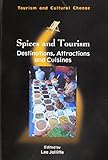Spices and Tourism : Destinations, Attractions and Cuisines / ed. by Lee Jolliffe.
Material type: TextSeries: Tourism and Cultural Change ; 38Publisher: Bristol, UK; Blue Ridge Summit, PA : Channel View Publications, [2014]Copyright date: ©2014Description: 1 online resource (224 p.)Content type:
TextSeries: Tourism and Cultural Change ; 38Publisher: Bristol, UK; Blue Ridge Summit, PA : Channel View Publications, [2014]Copyright date: ©2014Description: 1 online resource (224 p.)Content type: - 9781845414436
- 9781845414443
- Culture and tourism -- Case studies
- Heritage tourism -- Case studies
- Spice trade -- History -- Case studies
- Spices -- Social aspects -- Case studies
- Hospitality industry
- Tourism industry
- BUSINESS & ECONOMICS / Industries / Hospitality, Travel & Tourism
- destination development
- heritage
- national cuisines
- spice farms
- spices
- tourism attractions
- tourism
- 394.1/2
- GT2870 .S75 2014
- GT2870 -- S75 2014eb
- online - DeGruyter
- Issued also in print.
| Item type | Current library | Call number | URL | Status | Notes | Barcode | |
|---|---|---|---|---|---|---|---|
 eBook
eBook
|
Biblioteca "Angelicum" Pont. Univ. S.Tommaso d'Aquino Nuvola online | online - DeGruyter (Browse shelf(Opens below)) | Online access | Not for loan (Accesso limitato) | Accesso per gli utenti autorizzati / Access for authorized users | (dgr)9781845414443 |
Frontmatter -- Contents -- Contributors -- Acknowledgements -- Introduction -- 1. Spices, Cultural Change and Tourism -- Part 1: Spice Destination Studies -- 2. Spices and Agro-Tourism on Grenada, Isle of Spice in the Caribbean -- 3. Spice Destination Case Study: Resident Perceptions of Tourism in Carriacou -- 4. Paprika: The Spice of Life in Hungary -- 5. Agriculture and Ecotourism in India's Goa Province: A Taste of Spices -- Part 2: Spice Attraction Studies -- 6. Rediscovering Spice Farms as Tourism Attractions in Zanzibar, a Spice Archipelago -- 7. The Role of Spice and Herb Gardens in Sri Lanka Tourism -- 8. The Tropical Spice Garden in Penang, Malaysia -- Part 3: Spice Product Studies -- 9. Australian Native Spices: Building the 'Bush Tucker' Brand -- 10. Pure, Fresh and Simple: 'Spicing Up' the New Nordic Cuisine -- 11. Recognition of Spices and Cuisine as Intangible Heritage -- Conclusion -- 12. Lessons for Spice-related Tourism Destinations, Attractions and Cuisines -- Index
restricted access online access with authorization star
http://purl.org/coar/access_right/c_16ec
This is the first book to explore the relationship between tourism and spices. It examines the various layers of connection between spices and tourism in terms of destinations, attractions and cuisines. The book reveals how spice-producing destinations are employing spices in destination branding and encouraging spice farms to move towards tourism, while destinations not producing spices are employing spices and herbs in distinctive local cuisines. Both tangible and intangible spice heritages are highlighted as tools for developing destinations, creating attractions, inventing new forms of livelihoods and distinguishing local, regional and national cuisines. This volume will be useful for researchers and students in cultural tourism, culinary tourism, anthropology of food and food history.
Issued also in print.
Mode of access: Internet via World Wide Web.
In English.
Description based on online resource; title from PDF title page (publisher's Web site, viewed 30. Aug 2021)


